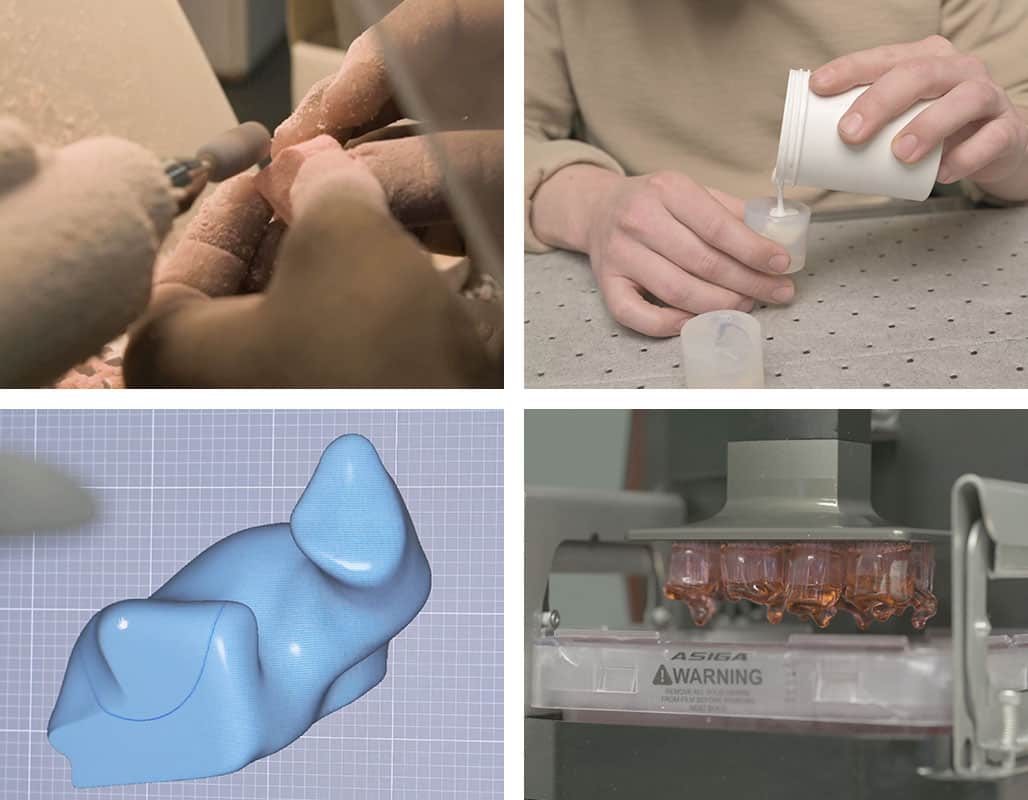Are 3D printed in ear monitors better?
Are 3D printed in-ears better than hand-poured?
Is a 3D printed in-ear better than one that is hand-poured?
Do 3D printed monitors fit better?
We hear these questions quite often and see them addressed in various FAQs and videos online. So we thought we’d take a couple of minutes to give you the facts on 3D printed in-ear monitors.
First, some background on us. We have been in the hearing industry for decades. Our parent company manufactures impression material for audiologists all over the world. So we’re speaking from quite a bit of experience here.
The differences in a hand-poured monitor vs. a 3d printed in-ear monitor
Hand-poured shells, thickness for thickness are stronger than a 3D printed shell. The scientific word for it is “thixotropic”. That means that the acrylic particles bond in every direction, where a 3D printed shell bonds only to the layer below it. It’s like a Velcro ball vs. a Lego. Velcro (thixotropic) can stick on the whole surface where Legos only bond on a single surface. That makes a properly hand-poured shell stronger than a 3D printed shell.
At Alclair, we have worked to make the 3D printed in ear monitor shells as strong as a hand-poured shell. Adjusting the thickness and strengthening potential impact areas are a couple of the areas we have made our 3D printed shells stronger than most.
Whether hand poured or 3D printed, monitors are precision instruments that do not like to be dropped. Please take care of them like you would an expensive custom made instrument because, well, they are! When dropped, the acrylic shells can crack, regardless of the production method. Beyond cracks, dropping a balanced armature driver can cause it to become unbalanced. Then it sounds distorted and gross. We will need to replace the driver to repair them.
Note, its nearly impossible to blow a balanced armature driver through high input levels. They can take a lot. But they don’t like collisions with each other, floors, or drum sticks. When we hear from a customer that their monitors are blown…. 9 times out of 10 is damage from impact.
And now the big BUT.
BUT. When people are talking about whether a 3D printed in ear shell is better or hand-poured is worse, that’s not really the right conversation.
The right conversation is not, is 3D better, but is “e-detailing” better. Oh, now there is something cool to talk about.
An e-detailed impression can produce a better fitting in-ear monitor that can be reproduced exactly
There are two kinds of detailing we will talk about here. Hand detailing and e-detailing. With hand detailing, a detailer trims the impression of your ear. The audiologist makes an impression of your inner ear and then we trim it to look like an in-ear monitor.
A well-trained impression detailer will have experience detailing hundreds of impressions. This experience gives them the ability to take an impression and trim it down to make a perfect in-ear monitor. But this is becoming a lost art. In order to continue making great impressions for years to come, we have to make some changes.
For e-detailing, we start with a scan of the impressions you send in (or your digital impressions) and digitally detail your impressions. When e-detailing, the software has a massive library where it has “learned” what needs to be adjusted. While a single hand detailer needs hundreds of impressions to become an expert, the software lends us that expertise from the very first impression.
Some other benefits are the ability to “undo”, which is impossible for a hand impression detailer. Also, we can reproduce any adjustments we make as those adjustments lives in a digital record. Every impression we e-detail adds to the software’s impression detailing database.
So really, 3D printed in ear monitor shells are not more accurate than hand-poured shells. If anything, hand-poured shells can still be stronger. It’s that an e-detailed impression can be more accurate than a hand detailed impression.
What does this mean for you?
At Alclair, we e-Detail all the impressions that come into the shop. That means you can expect an incredible fitting monitor. There are still some variables in the impression taking process and individual anatomy. Our SureFit guarantee assures your monitors will fit perfectly.
At Alclair, we make both 3D printed in-ear monitor shells and hand-poured shells. Which one we use has to do with what colors you select. Since 3D printing is done in batches, we print fewer colors with 3d printed shells. Hand pouring on the other hand (see what we did there) can be almost any color you can imagine. Due to e-Detailing, you can get a perfect fit in any of our hundreds of color combinations. And that sounds like a great fit to us.





